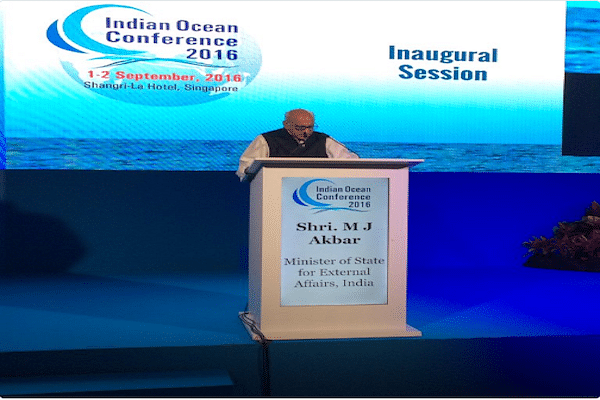World
Indian Ocean Conference 2016: Takeaways And Reflections On A Critical Event
- The Indian Ocean Conference in Singapore just set the right tone for regional cooperation and diplomacy.

M J Akbar delivering the welcome address at the Indian Ocean Conference 2016 in Singapore. (Twitter, M J Akbar)
I moved to Singapore a decade ago. That was a time when India was known for its tacky Bollywood movies and tackier Diwali decorations in Little India (an area of Singapore inhabited by South Asians).
Our early experiences of Singapore were house-owners refusing to rent us homes and an overly friendly colleague asking me, “How come you don’t have body odour, man?”, without realising how racist that remark was.
That was then.
The last week saw a sea-change in India’s image when the India Foundation pulled off a gathering that could easily have been the envy of the 21 countries that participated in it. Heads of States, Ministers, diplomats, journalists and thought leaders from different countries rubbed shoulders and discussed the future of the Indian Ocean region and each of our roles in it.
Now, to set the expectations straight: this is neither an article documenting the minutes of the meeting nor a conference report. Quite far from it, actually. This article is purely about my individual takeaways from the Indian Ocean Conference (IOC) 2016. A very personal, fly-on-the-wall account of a desi figuring out what this means for India.
Shared Identity
The Thai Minister of Culture, Vira Rojpojchanarat, set the tone for the conference by reminding delegates of the Sanskrit roots of his name (Vira means brave in Sanskrit). What followed was a unilateral consensus of the shared histories and shared identities across the Indian Ocean region. On how, at the very core, we are a very similar set of people – we have similar roots, similar family structures and similar outlook towards life, prosperity and spirituality, but just that we don’t remind ourselves of that enough.
Shared Culture
Sri Sri Ravi Shankar brought up easy-to-digest binary constructs, like, for commerce, you look to the west and for culture, you look east. It is time the Indian Ocean region exported its culture (spirituality, happiness, trust structures, etc.) in the way that the West has exported its commerce.
I have personally believed that the West’s perceived “superiority” comes from the ‘ease of measurement systems’. It is easier to measure if A is richer than B; therefore, wealth becomes the singular measure of success. Now imagine a world where you could measure other intangibles, like happiness, culture or health. That world is already just around the corner. Would our views change on a change in a nation’s measure of “superiority” (say, a prosperous nation with the lowest rank on the happiness index)? Would our exports change (Yoga and Vasudaiva Kutumbakam instead of iron ore)?
Shared Power
From a geo-political perspective, no country in the Indian Ocean region is a superpower. Not yet. Getting there, though, needs to be a symbiotic process of taking the region along. Whether it is reinvigorating the Indian Ocean Rim Association (IORA), rethinking bilateral engagements, enhanced people-to-people platforms, or plain simple opening up of markets and trade – it is clear that a closer association is enormously mutually beneficial.
Shared Equilibrium
Singapore’s Foreign Minister, Dr Vivian Balakrishnan, stated:
Now think about that for a second. Here is the Indian Ocean Region, a part of the world that has been the hub of maritime trade and activity. However, largely speaking, their maritime military might has been largely defensive in nature. Using those ships for spices and silk instead of armies and armaments means an acute mutual respect for co-existence and equilibrium.
Shared (Geo-Political) Challenges
“Investment in conquest has to be worth the return. No one attacks a poor country,” said M J Akbar, India’s Deputy Foreign Minister. Now, what does that mean to a region that is building prosperity at a breakneck speed? While it is not the era of widespread wars that play out publicly, what kind of response should we expect from the countries that currently hold a dominant status and feel threatened? Are we ready with those responses?
In conclusion
Lines were drawn later: Anyone that travels around the region can’t help but notice the ‘korma’ curry in Malacca, or streets in Thailand named after characters from the Ramayana, or profound Indic structures in Cambodia and Indonesia. The connections are centuries old. The lines on the maps, though, are just 70 years old.
Let me clarify that I’m not questioning sovereign rights, nor suggesting any drastic political moves. However, the conference made me ask a simple yet profound question: What if we were to start looking at 2016 as just a point in time in a much longer history (of this region), and what if we use a soft-focus lens on the lines on the maps?
Introducing ElectionsHQ + 50 Ground Reports Project
The 2024 elections might seem easy to guess, but there are some important questions that shouldn't be missed.
Do freebies still sway voters? Do people prioritise infrastructure when voting? How will Punjab vote?
The answers to these questions provide great insights into where we, as a country, are headed in the years to come.
Swarajya is starting a project with an aim to do 50 solid ground stories and a smart commentary service on WhatsApp, a one-of-a-kind. We'd love your support during this election season.
Click below to contribute.
Latest